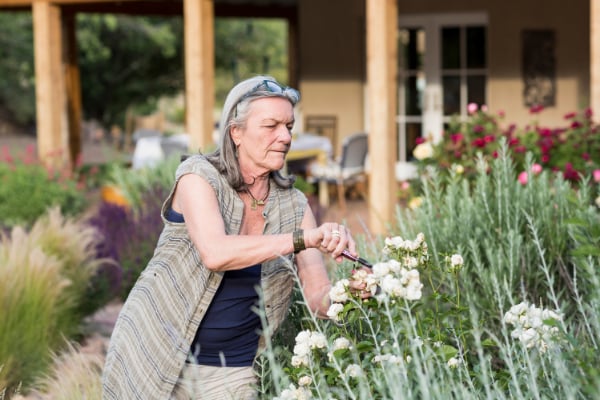Common Rose Leaf Problems
Problems with rose leaves can always be traced to an underlying issue affecting the plant as a whole. This could be a fungal infection, an insect infestation, nutritional imbalance, soil problem, heat stress or something else.
Whatever the cause, the foliage of roses is generally the first place you’ll see the telltale signs of a problem, with leaves becoming discoloured and sometimes wilting or dropping off the plant prematurely. This, in turn, leaves the plant less able to photosynthesise.

Read on for some commonly seen symptoms of disease in rose leaves, and tips for keeping your roses healthy.
Symptoms of disease in rose leaves
Yellowing
There are numerous possible reasons for a plant’s leaves turning yellow, ranging from nutrient deficiencies to fungal infections. Therefore, you’ll probably need to look for other clues to get to the bottom of the problem.
For example, yellow leaves with black spots on roses generally indicates a fungal infection (see below), whereas the lower leaves yellowing and falling off (without spots) is often a sign of heat stress, a watering issue or nutrient deficiency.
Black spots
Black spots on rose leaves are usually caused by the aptly named blackspot fungus. The spots are typically accompanied by a yellowing of the leaves, which eventually fall off the plant.

This is a common condition but can place your rose plants under significant stress over time.
Keep in mind that some nutrient deficiencies can show up as yellowed leaves with darker spots, which could be mistaken for blackspot fungus.
White spots
A white fuzz on new foliage is usually a sign of powdery mildew, another fungus commonly seen on roses. It can begin as small white spots, which then develop into a fuzzier mass on the leaves. Eventually, leaves wilt and fall off the plant.
Rust-coloured coating
If you find a raised, orangey coating on the undersides of the leaves, it is probably a type of fungal infection commonly known as rust. It mostly affects the older foliage on roses, causing them to lose vigour.

Sooty black coating
This could be a sign of a scale infestation, and perhaps quite a severe one. Scale refers to tiny insects that suck sap from the stems and leaves of roses, meanwhile secreting a substance that causes this sooty black mould to form on the leaves. Over time, this interferes with the plant’s ability to photosynthesise and will reduce its overall health.
Mottled, pale colouring
This is often caused by the two-spotted mite. If you look closely, these can often be seen, along with their fine webs attached to the plant. Shrivelled, bronzed leaves can also be a sign mites. Unless the infestation is really severe, natural predators will generally take care of them.
Preventing rose diseases
There are many techniques, sprays and treatments for getting rid of the issues listed above.
Still, we all know that prevention is better than cure, and keeping your roses healthy and happy will help build resistance to disease. This will help them retain their foliage, which in turn feeds back into healthy plants that also look their best.
Planting and positioning
Roses need full sun and well drained soil enriched with plenty of organic matter. When planting, leave plenty of room between plants, as insufficient airflow and sunlight can encourage fungal infections. Mulching helps keep out unwanted competition for nutrients and regulate soil temperature.

Watering
Roses aren’t drought tolerant plants, with insufficient water leaving them stressed and more vulnerable to diseases. Water thoroughly around the entire root zone, which is generally similar diameter to the crown of the plant and can be up to 50cm deep. Check that the water is effectively penetrating the soil.
Be sure to water into the roots, not the leaves, as excess moisture on the leaves can encourage fungi. For this reason, drip irrigation is a better choice for automated rose watering than sprinklers.
Fertilising
Roses need to be fertilised correctly, both in terms of fertiliser type and quantity. Using the wrong fertiliser, or too much or not enough of the right one, will leave roses vulnerable to problems. The simplest way to get it right is buy a pre-made fertiliser formulated for roses and follow the instructions carefully.

Pruning
Pruning roses is important to ensure adequate air flow to all parts of the plant – this is usually done by pruning into a vase-shape and removing old wood.
When doing this, it’s essential to practice good hygiene with your secateurs so as not to transfer any diseases between plants. Ideally, clean tools with bleach and water after working on each individual rose bush (as well as other plants).

Check for problems
Check your roses regularly, inspecting the leaves for signs of problems. Any leaves that do not look healthy should be removed and disposed of (not in the compost), and any fallen leaves cleaned up as much as possible. This will help minimise any diseases spreading.
Grow healthier roses
Is your rose care toolkit in need of an update? Garden Express stocks a great range of pruning tools from Felco and Darlac, fertilisers and other accessories, along with a fantastic selection of rose plants. Leaves are just a part of the rose, if you are looking for more rose care tips read here.







Comments are closed.